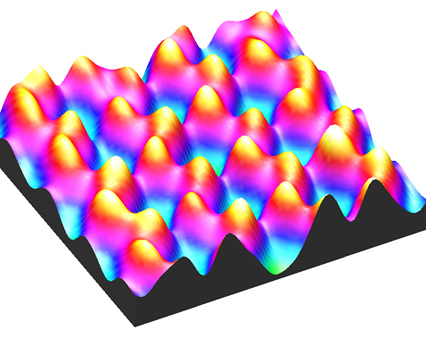The Complexities of a Simple Molecule
Carbon dioxide reveals a predilection for tumbling alone and lining up together
(December 2012)

Carbon dioxide diffuses on titanium rows by a tumbling mechanism. Once bound to a titanium atom, the carbon dioxide's axis tilts.
Results: Crowded together on a titanium dioxide surface, carbon dioxide molecules relinquish their free-tumbling ways to form crooked lines and cling to molecules in nearby lines, according to scientists at Pacific Northwest National Laboratory. Bringing together a trio of instruments and a supercomputer, the team joined experiments and theory to understand carbon dioxide's behavior.
"We want to build our understanding from the ground up," said Dr. Zdenek Dohnalek, an experimental chemist on the study. "We want to understand the interaction of carbon dioxide with well-known models of oxides, such as titanium dioxide."
Why It Matters: Understanding how carbon dioxide molecules behave is basic science needed by the energy sector to facilitate carbon sequestration and fuel production. Sequestration stores carbon dioxide emissions from power plants underground. Fuel production uses the carbon dioxide as a building block to create fuels.
"While titanium dioxide is a model material that will likely not be used to sequester carbon dioxide or serve as a catalyst for fuel conversion, the fundamental aspects of carbon dioxide reactivity revealed in our study are very intriguing," said Dr. Xiao Lin, a Linus Pauling Postdoctoral Fellow at PNNL, who proposed this research as part of his fellowship.
Methods: For this study, the team took a complex approach. "To make progress, you need to marry theory and experimentation," said Dr. Nikolay Petrik, an experimental scientist at PNNL who worked on the study. "With these types of collaborations, we can reach much deeper understanding."
They brought together a powerhouse of tools in EMSL. With a scanning tunneling microscope purchased with American Recovery and Reinvestment Act funds, the team obtained images of the carbon dioxide molecules on the titanium dioxide surface. The images are similar to photographs taken with a long exposure at night, showing the motion of carbon dioxide and places it visited. In addition, the team used infrared reflection adsorption spectroscopy and a temperature-programmed desorption technique to learn about the orientation of molecules and their binding to the catalyst. The use of a molecular beam system allowed them to measure when the surface is totally covered with carbon dioxide.
The theoreticians used molecular dynamics and dispersion-corrected density functional theory, powerful calculations and simulations that explained the results obtained in the experiments. "We did the first very detailed simulations that used multiple carbon dioxide molecules," said Dr. Yeohoon Yoon, a postdoctoral fellow at PNNL who has worked on this study for 2 years. "These are the kind of results that will help other people go further."
"To get the results to agree on all the points, we had to dig much deeper," said Dr. Roger Rousseau, a chemical theoretician on the project. "We could come up with a convincing story to explain any one result, but the multiple instruments let us nail down the details more than we could have otherwise."
The team found that when only a few molecules are added, they tumble about the titanium dioxide surface. On the atomic level, the material's surface is like a row of cornstalks. To either side rise rows of oxygen atoms, with some of the atoms missing and creating defects in otherwise perfect structure. Between the oxygen rows are the rows of titanium atoms. The solitary carbon dioxides settle onto the titanium atoms. Moving along the surface takes little energy, so the carbon dioxide skates along the surface even when the temperatures, and available energy, drop to 50 Kelvin or about -370 degrees Fahrenheit.
When more carbon dioxide is added, the interactions with their neighbors start to come into play. "The molecules stop moving when they get too crowded. They are forced to find a single comfortable position," said Dohnalek.
The molecules start to arrange into lines as they are settling in the titanium aisles. The lines aren't completely straight; rather they form a zigzag pattern. "The zigs and zags mean the carbon dioxide is tilting -- alternating to one side of the aisle or the other. Interestingly, the zigzag lines tilt toward each other in the neighboring rows," said Rousseau.
What's Next? "We want to go to more complex and realistic systems," said Rousseau. "Titanium dioxide could be a support, so we want to know the structures and binding configurations. This is laying the groundwork for future studies where we will put metals on titanium dioxide or use different oxides to look at how the chemistry changes when you make the system more complex."
The researchers are looking at adding ruthenium dioxide to the titanium and determining how the carbon dioxide reacts. The ruthenium dioxide is of interest because of its reactivity.
Acknowledgments:
Sponsors: This research was funded by two sources. Xiao Lin was funded by the Linus Pauling Distinguished Postdoctoral Fellowship Program funded by Laboratory Directed Research and Development Program at PNNL. The other researchers were funded by the U.S. Department of Energy, Office of Basic Energy Sciences, Chemical Sciences, Geosciences & Biosciences Division
User Facility: EMSL
Research Area: Chemical Sciences
Research Team: Xiao Lin, Yeohoon Yoon, Nikolay Petrik, Zhenjun Li, Zhi-Tao Wang, Vassiliki-Alexandra Glezakou, Bruce Kay, Igor Lyubinetsky, Greg Kimmel, Roger Rousseau, Zdenek Dohnalek, Pacific Northwest National Laboratory.
Reference: Lin X, Y Yoon, NG Petrik, Z Li, ZT Wang, VA Glezakou, BD Kay, I Lyubinetsky, GA Kimmel, R Rousseau, and Z Dohnalek. 2012. "Structure and Dynamics of CO2 on Rutile TiO2(110)-1x1." Journal of Physical Chemistry C 116 (50):26322-26334. DOI: 10.1021/jp308061j
